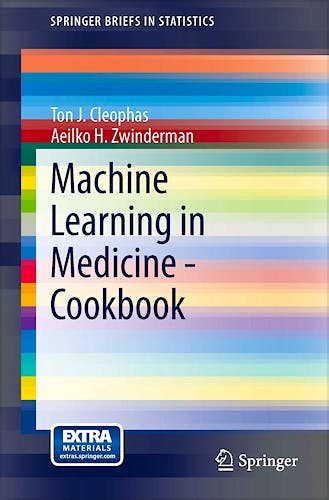

No hay productos en el carrito



Machine Learning in Medicine - Cookbook (Springerbriefs in Statistics)
Cleophas, T.J. — Zwinderman, A.H.
1ª Edición Enero 2014
Inglés
Tapa blanda
137 pags
500 gr
16 x 23 x 1 cm
ISBN 9783319041803
Editorial SPRINGER
ABOUT THIS BOOK
- Machine learning is an innovation in the medical field
- So far a book on the subject to a medical audience has not been published
- The book is time-friendly
- The book is multipurpose, (1) an introduction for the ignorant, (2) a primer to the inexperienced, (3) a self-assessment handbook for the advanced inexperienced, (4) a self-assessment handbook for the advanced
- The methods selected and described have been tested in real life and by the authors
The amount of data in medical databases doubles every 20 months, and physicians are at a loss to analyze them. Also, traditional methods of data analysis have difficulty to identify outliers and patterns in big data and data with multiple exposure / outcome variables and analysis-rules for surveys and questionnaires, currently common methods of data collection, are, essentially, missing.
Obviously, it is time that medical and health professionals mastered their reluctance to use machine learning and the current 100 page cookbook should be helpful to that aim. It covers in a condensed form the subjects reviewed in the 750 page three volume textbook by the same authors, entitled “Machine Learning in Medicine I-III” (ed. by Springer, Heidelberg, Germany, 2013) and was written as a hand-hold presentation and must-read publication. It was written not only to investigators and students in the fields, but also to jaded clinicians new to the methods and lacking time to read the entire textbooks.
General purposes and scientific questions of the methods are only briefly mentioned, but full attention is given to the technical details. The two authors, a statistician and current president of the International Association of Biostatistics and a clinician and past-president of the American College of Angiology, provide plenty of step-by-step analyses from their own research and data files for self-assessment are available at extras.springer.com.
From their experience the authors demonstrate that machine learning performs
sometimes better than traditional statistics does. Machine learning may have
little options for adjusting confounding and interaction, but you can add propensity
scores and interaction variables to almost any machine learning method.
Content Level » Professional/practitioner
Keywords » Clinical data analysis - Computer science - Data management
- Data mining -Machine learning
Related subjects » Image Processing - Information Systems and Applications
- Life Sciences, Medicine & Health – Medicine
© 2025 Axón Librería S.L.
2.149.0